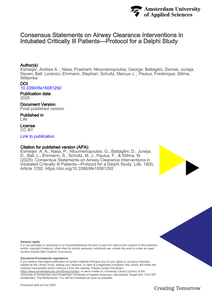Intubated critically ill patients are susceptible to secretion accumulation because of compromised airway clearance. Various airway clearance interventions are employed to prevent complications arising from mucus retention. This Delphi study aims to collect global opinions in an international expert panel of ICU professionals on the usefulness of these various airway clearance interventions. A steering committee performed a literature search informing the formulation of statements. Statements are grouped into two distinct parts: (1) Humidification and Nebulization, and (2) Suctioning and Mucus mobilization techniques. For each part, a diverse panel of 30–40 experts will be selected, with concerted effort to involve experts from various medical specialties involved in airway clearance methods. Multiple choice questions (MCQs) or 7-point Likert-scale statements will be used in the iterative Delphi rounds to reach consensus on various airway clearance interventions. Rounds will continue until stability is achieved for all statements. Consensus will be deemed achieved when a choice in MCQs or a Likert-scale statement achieves ≥75% agreement or disagreement. Starting from the second round of the Delphi process, stability will be assessed using non-parametric χ2 tests or Kruskal–Wallis tests. Stability will be defined by a p-value of ≥0.05.
DOCUMENT

BACKGROUND: Cystic fibrosis is an inherited life-limiting disorder, characterised by pulmonary infections and thick airway secretions. Chest physiotherapy has been integral to clinical management in facilitating removal of airway secretions. Conventional chest physiotherapy techniques (CCPT) have depended upon assistance during treatments, while more contemporary airway clearance techniques are self-administered, facilitating independence and flexibility.OBJECTIVES: To compare CCPT with other airway clearance techniques in terms of their effects on respiratory function, individual preference, adherence, quality of life and other outcomes.SEARCH STRATEGY: We searched the Cochrane Cystic Fibrosis and Genetic Disorders Group trials register which comprises references identified from comprehensive electronic database searches and handsearching of relevant journals and abstract books of conference proceedings. We also searched CINAHL from 1982 to 2002 and AMED from 1985 to 2002. Date of most recent search: January 2004.SELECTION CRITERIA: Randomised or quasi-randomised clinical trials including those with a cross-over design where CCPT was compared with other airway clearance techniques. Studies of less than seven days duration were excluded.DATA COLLECTION AND ANALYSIS: Two reviewers allocated quality scores to relevant studies and independently extracted data. If we were unable to extract data, we invited authors to submit their data. We excluded studies from meta-analysis when data were lost or study design precluded comparison. For some continuous outcomes, we used the generic inverse variance method for meta-analysis of data from cross-over trials and data from parallel-designed trials were incorporated for comparison. We also examined efficacy of specific techniques and effects of treatment duration.MAIN RESULTS: Seventy-eight publications were identified by the searches. Twenty-nine of these were included, representing 15 data sets with 475 participants. There was no difference between CCPT and other airway clearance techniques in terms of respiratory function measured by standard lung function tests. Studies undertaken during acute exacerbations demonstrated relatively large gains in respiratory function irrespective of airway clearance technique. Longer-term studies demonstrated smaller improvements or deterioration over time. Ten studies reported individual preferences for technique, with participants tending to favour self-administered techniques. Heterogeneity in the measurement of preference precluded these data from meta-analysis.AUTHORS' CONCLUSIONS: This review demonstrated no advantage of CCPT over other airway clearance techniques in terms of respiratory function. There was a trend for participants to prefer self-administered airway clearance techniques. Limitations of this review included a paucity of well-designed, adequately-powered, long-term trials.
DOCUMENT
BACKGROUND: Chest physiotherapy is widely prescribed to assist the clearance of airway secretions in people with cystic fibrosis (CF). Positive expiratory pressure (PEP) devices provide constant back pressure to the airways during expiration. This may improve clearance by building up gas behind mucus via collateral ventilation. Given the widespread use of PEP devices, there is a need to determine the evidence for their effect.OBJECTIVES: To determine the effectiveness and acceptability of PEP devices compared to other forms of physiotherapy as a means of improving mucus clearance and other outcomes in people with CF.SEARCH STRATEGY: We searched the Cochrane Cystic Fibrosis and Genetic Disorders Group Trials Register comprising of references identified from comprehensive electronic database searches and handsearches of relevant journals and abstract books of conference proceedings. The electronic database CINAHL was also searched from 1982 to 2001. Most recent search of the Group's register: February 2006.SELECTION CRITERIA: Randomised controlled studies in which PEP was compared with any other form of physiotherapy in people with CF.DATA COLLECTION AND ANALYSIS: Two authors independently applied the inclusion and exclusion criteria to publications and assessed the quality of the included studies.MAIN RESULTS: Forty studies were identified and twenty-five studies involving 507 participants met the review inclusion criteria. Most included studies had low scores on a scale of study quality. Twenty of these studies involving 300 participants were cross-over in design. Data were not published in sufficient detail in most of these studies to perform meta-analysis.Forced expiratory volume in one second (FEV1) was the most frequently measured outcome. Single interventions or series of treatments continued for up to three months demonstrated no significant difference in effect between PEP and other methods of airway clearance on FEV1. Long-term studies had equivocal or conflicting results regarding the effect on FEV1. Participant preference was reported in nine studies. In all studies with an intervention period of at least one month, measures of participant preference were in favour of PEP. The results for the remaining outcome measures were not examined or reported in sufficient detail to provide any high level evidence.AUTHORS' CONCLUSIONS: There was no clear evidence that PEP was a more or less effective intervention overall than other forms of physiotherapy. There was limited evidence that PEP was preferred by participants compared to other techniques, but this finding is from studies of low quality.
DOCUMENT